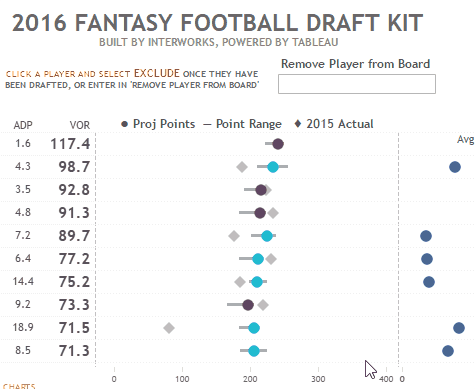This blog post is Human-Centered Content: Written by humans for humans.
Football season is almost upon us. While we slog through the purgatory that is preseason matchups, some very real preparations are starting to get underway: drafting the perfect fantasy football lineup. Drafting your favorite players and hoping for the best is, uh, one strategy. Another strategy is using actual data to inform your decisions.
While there are always surprises through the season, and historical performance isn’t always predictive of future performance, basing your decisions on data gives you better shot to win your leagues. The only challenge with the data-driven approach is piecing it all together. That’s why I created this Tableau Fantasy Football Draft kit back in 2016, which has now been updated for the 2023 season. Everything you need to make intelligent picks is loaded onto this interactive dashboard.
How to Use This Kit
The kit works very much the same as last year’s. This Tableau viz is meant to be used while you draft your league. The design is simple and displays only the most pertinent info.
The draft list can be found in the middle of the dashboard and is the most important part. It shows you which player to draft next base on Value Over Replacement (VOR). More info on VOR is provided below.
At the bottom-right, you’ll see available players per position (non-DF/K) by point expectation buckets. As you take players off the board, the chart will update and show you the remaining talent pool.
The bottom-middle chart shows the top ten teams by total expected fantasy points. This is useful when choosing between players with close VORs. A team projected to score more points will also be more likely to spread those points around better than those that score less. You can filter the draft list by clicking the position spread at the bottom-left and the team list at the bottom-middle.
The draft list is automatically sorted by Value Over Replacement, which is the most important metric in good draft strategies. Each player’s information (team, BYE, etc.), their VOR, expected range of points with consensus target and last year’s actual total points are displayed alongside the relative risk per player. There’s a glossary of these acronyms at the bottom of this post if you need a refresher.
Average auction draft values per player ($200 standard pool), age and years in NFL. Users can toggle between showing the Risk calculation or Auction Value.
I recommend reading through this whole post and familiarizing yourself with all the acronyms. You might even practice drafting before you do the real thing. It will give you familiarity with taking players off, filtering by position or team and keeping up with the draft in general.
I like to use a laptop when drafting, so I can check news and depth charts to avoid injured or benched players. It’s a safe strategy to pick whomever is at the top of the draft list when it’s your turn. Second quarterback is the exception here, but you can do that much later in the draft. I also recommend not drafting a team defense or a kicker. You won’t want more than one of either during the season, especially when you draft.
NOTE: As each player is picked, they need to be cleared from the draft list by clicking their name (or anything else on the row, circles, etc.) and clicking “Exclude” from the pop-up OR by typing a portion of their name in the “Remove Player from Board” box, hitting enter, then clicking the player.


Metrics
Some of the terms you’ll need to be familiar with to use these kits are listed below:
- Rank: Overall rank by VOR
- POS: Position
- VOR: Value Over Typical Replacement Player. Used to rank players across positions. Calculated by comparing players’ projected points to a “typical” replacement player at the same position (determined by VOR baseline values). For more info on how VOR is calculated, see here.
- Points: Average projected points for a player across analysts
- ECR Rank: Expert Consensus Ranking from FantasyPros
- Pos Rank: Position rank
- ADP: Average Draft Position
- AAV: Average Auction Value
- Risk: Risk of injury and degree of uncertainty of players’ projected points, calculated as the average of 1) injury risk from Sports Injury Predictor and 2) the standard deviation of the players’ projected points and rankings across analysts. Standardized to have a mean of 5 and a standard deviation of 2 (higher values reflect greater risk).
ADP can help you identify if a player is going too early/late in your draft and is a great place to look for value later in the draft. If you’ve been diligently drafting by VOR and have a good team, but you still need an RB or WR on the bench, ADP can help you identify players that are available later than they should be. Your drafting site should be keeping track of what pick number your draft is at all times. If it’s the 100th pick and you see an ADP of 65 available, you should take a peek at that player’s news (linked when you click on a player in my draft kit) to see if there’s something going on with that player. Likewise, you’ll want to avoid drafting an ADP of 65 if it’s only the 20th pick.
Finally, remember that whatever you do on this Tableau dashboard won’t affect your actual draft. You still need to draft your players on your website. Be sure to also keep up with draft pick filtering as players go off the board. If you don’t, you may waste time drafting an unavailable player and scrambling for a replacement.
NOTE: If you want to download these for yourself, both the standard and PPR versions are on Tableau Public.

